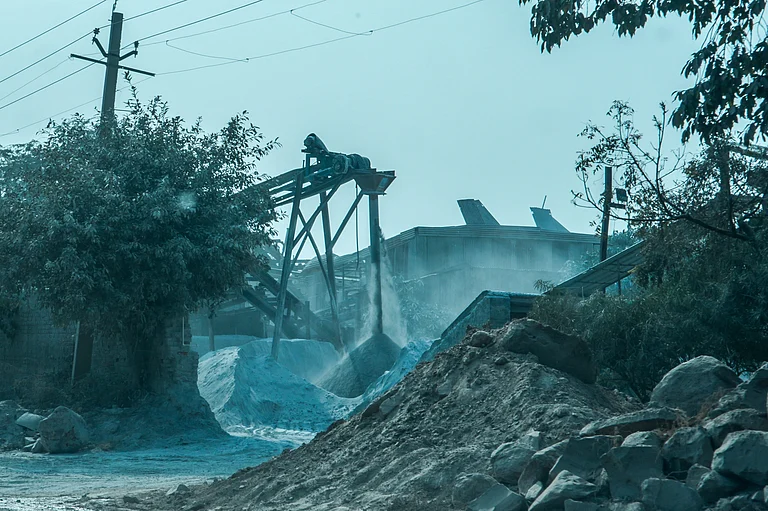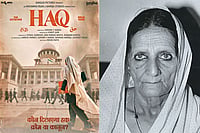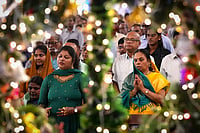Alchi reveals itself to the visitor hesitantly. As you leave the highway from Leh, take the sharp left to go on the bridge over a speeding Indus and climb up the curvaceous road, the village remains almost hidden even when the milestone shows ‘Alchi 1 km’. Then as the road slopes down, some tree tops of the tallest poplars are made visible, assuring you there is indeed a village, a habitat, down there.
Suddenly the vista opens up—fields of a peculiar green only the thin, rarefied atmosphere of Ladakh can conjure and scattered among them are little squares of a transcendent yellow, again of a hue not to be found in the plains or the more familiar hills of Himachal or Uttarakhand. This, against the stark, barren, sweeping browns of the mountains in the background make them seem like precious stones studded in an enormous ornament.
As the road winds down to the village square, you are shaken off of the dream that you are in some wonderland. Aluminium-doored shops displaying hoops of Haldiram namkeen and Lays chips, an eatery with Chinese, Continental, Indian cuisine, and diesel smoke of the taxi stand make you land on reality.

Is the river taunting the monastery of its wrinkles and cracks or the monastery rolling its eyes at the river’s restlessness—it is difficult to say. But they have seen each other for over 700 years. Unlike in the other villages, the monastery in Alchi is at its edge rather than at the top. You walk through the little bazaar of some 20 curios shops, fast-talking women selling all kinds of antique and imitation artifacts, making it sound as if they are parting with their heirlooms than selling merchandise, and at the end is the monastery.
It is not showy, there is no giant Buddha looking over it, no ostentatious carvings on its walls, just a scattering of plain-looking temples. But something engulfs you when you enter it, the mist of age hanging over its precincts, wise and a little bewildered by all it has seen; the gnarled willows which must have heard millions of prayers, complaints and thanks. The paintings of the Buddha’s life inside the temples are mesmerising—who were these monks, how did they make these colours, what made them paint? (I’m sure Google has all the answers, but luckily your phone is deposited outside).
Curiously, the offerings in the temples are Real Mixed Fruit juice, Krackjack biscuits, Fortune soyabean oil and other BlinkIt goods. Who is to say gods prefer milk, coconuts and bananas—maybe they can be appeased with a party-pack of kurkure as well!
The best-kept secret of Alchi is right at its entrance though. Even before those emerald fields, before the model school, before the homestays begin, there is a stretch full of smooth-looking rocks. At first glance they seems like just rocks strewn across a field, a common sight in Ladakh. But when you look closely, there are intricate carvings on them—animal figurines, hunting scenes, stupas.
These petroglyphs are known to be older than the monastery, some about 3,000 years old, from the Iron Age. The stones were scattered all across Alchi. A few years ago, the community got together and collected them all in this field. Sadly, most day-trippers coming to the village miss it and go straight to the monastery and the bazaar.
It is the doughty Nilza Wangmo, who runs the all-women Alchi Kitchen, and her teenage daughter Seral, who is here on summer vacation from her boarding school in Nainital, who take us to see the rock art. Alchi Kitchen has ensnared us with its heady aromas, delectable local dishes and the ready laughter of the women cooks and waiters. Nilza has fought many battles to make a success of it—a photo of her receiving the Nari Shakti Award from former President Kovind is proudly displayed at the counter.
As we are virtually living there, Nilza offers to cook something out of the menu for one dinner. She has plucked a basket of Swiss chards from her garden, and there is a pile of local wild mushrooms. In a pan, she pours a little mustard oil, adds a few garlic cloves and some crushed peppercorns. As these splutter, she adds the chards whole, unevenly cut mushrooms, a little water and a big handful of sundried tomatoes, nicely toasted in the Ladakh sun. And voila, there’s magic, the liquidy greens bursting with umami, so divine with the local bread khambir, in that warm kitchen with a cool, clear night outside.
MORE FROM THIS ISSUE
(Satish Padmanabhan is the Managing Editor, Outlook magazine)



































